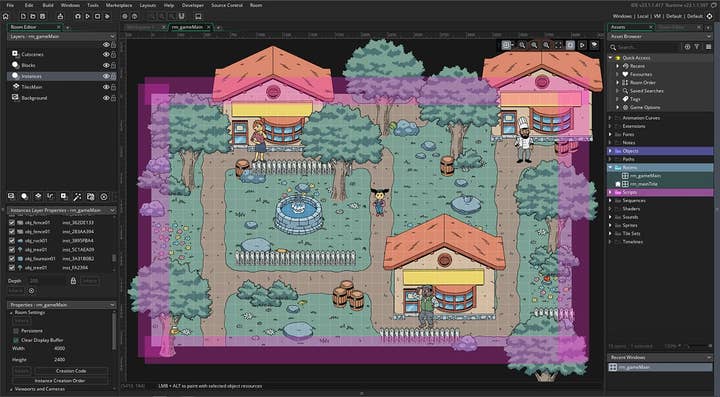Getting developers started with GameMaker
Gurpreet Singh Matharoo talks us through how the company is making it easier for newcomers to get to grips with the 2D-centric game engine
It’s been almost 25 years since Dutch professor Mark Overmars created GameMaker, a game engine primarily devoted to 2D graphics and sprites.
While major engines like Unity and Unreal Engine also offer 2D tools in addition to cutting-edge visuals, GameMaker keeps things simple with its drag-and-drop visual scripting tool. Its 2D focus has helped small teams create incredible experiences like Hyper Light Drifter, Hotline Miami, Chicory: A Colorful Tale, and Undertale.
GameMaker also saw a boost in awareness and use last year; just as Unity walked into a massive pricing controversy last year, GameMaker flipped the script and made its tech free for all non-commercial use.
We sat down with Gurpreet Singh Matharoo, a lead technical writer at GameMaker, to discuss how GameMaker plans to entice developers who weren't fans of the Unity fiasco. Matharoo works in the team responsible for the company’s documentation in addition to video content on their YouTube channel, "aimed primarily at first-timers to GameMaker."
Matharoo was quick to state that it’s "not particularly hard to create documentation and fill it with information"; instead the challenge lies in "making it easily digestible for new users, while keeping it informative for seasoned developers."
"For new users, I ensure that my writing (and that of my staff) is made up of short paragraphs, uses simple words that a fourth-grader could understand, and gets to the point," he said.
Nurturing new talent is an imperative that is becoming increasingly important as established studios engage in layoffs across the industry. Despite rising profits and popularity, the age-old question of 'What's a young person hoping for a career in this sector meant to believe?' rears its ugly head.
While an indie gold rush would be held back by investor caution, there’s no denying that making games and creating them is becoming more accessible outside Western markets. GameMaker has its sights on a larger slice of an expanding pie.
"Developers can now export their [GameMaker] games to all desktop platforms, web, Android and iOS for free, for non-commercial use,’ Matharoo notes.
"Commercial exports are now a $100 one-time purchase, and half the price on Steam for Indian users. With GameMaker more financially accessible, I hope more people will adopt it as one of their engines."
"The time cost for making 3D games and financial cost of learning the required skills is high. 2D development is easier and achievable on more affordable machines"
Regional pricing can make all the difference, especially in countries that are beginning to embrace game subscriptions and digital purchases. But not everyone’s sold on this mode of expansion. Even fewer creators are optimistic about emerging tech like AI and NFTs.
As GameMaker’s parent company Opera collaborates with OpenAI, the game engine is also poised to implement AI, reportedly without sacrificing individual expression. The official GameMaker roadmap suggests that this AI assistant is still a work in progress. If done right, it could help novices as they build their first game. But there’s enough evidence of malpractice and talent theft that any AI implementation warrants extra scrutiny.
Another aspect of GameMaker’s approach to accessibility is effective documentation. Matharoo mentions that, for newcomers and experienced users alike, "you don’t want to hide anything." When it comes to deconstructing technical concepts, Matharoo relies on one word: dissection.
"When a set of features is presented to me [to document], it’s usually a full page of information presented in no particular order," he tells us. "It’s a substantial task to digest all that information and understand it fully. Once I have an understanding of the subject matter, I create a document and compartmentalize everything into separate sections and sub-sections."

Focusing on "crucial steps to use the system for the first time" and "anything that impacts their use of the system" helps Matharoo design a "beginner-friendly guide that even non-beginners can benefit from."
"I first make a high-level plan of what I’m going to document. I usually divide all information into separate pages. I ensure each page is clean and digestible, and don’t hesitate to add another page if it makes things simpler. Using links is also important, as it’s an invitation to the reader to read more."
"I hope more people within the industry educate others about game development and push schools to include game-making in their curriculum"
Matharoo likens it to going "deep into a Wikipedia rabbit hole."
As an engine geared towards 2D development, it’s no surprise that GameMaker is finding a user base in emerging markets.
"The time cost for developing 3D games and the financial cost of learning the required skills is high," Matharoo tells us. "2D development, on the other hand, is easier to kickstart and is achievable on more affordable machines. For developers with a passion for 2D games, that is all they need. That is where GameMaker supports the indie heart of India. The program is easy to access (Windows, Mac, and Linux) and does not require a particularly strong system. We even have a Chromebook beta!"
Despite the layoffs and the turbulent weather faced by the gaming industry, Matharoo remains optimistic. He believes that game development is "an incredibly fun hobby, and as an ever-growing industry, a perfectly viable career path."
"As a fun way to learn problem-solving, programming, art, music, and many other skills, it’s incredibly fruitful," he concludes. "I hope that more people within the industry educate others about game development and push our schools to include game-making as part of their curriculum."
